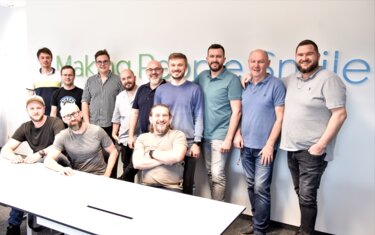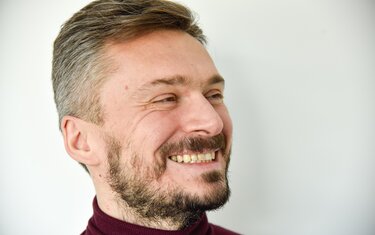Making Matija smile
Train-the-trainer concept: learning from each other
Twice a year, the Ivoclar Opinion Leaders from various Eastern European countries meet in Vienna to exchange information on the latest technologies, materials and workflows.
After the corona-related cancellations, or meetings held online, the expert group was able to meet again in person in Vienna in early summer. The approach this time was to promote exchange and shared learning.
Something that all dental technicians in the group have in common is an absolute dedication to the profession, the demand for perfection and the will to never stop on well-trodden paths. With this approach, each of the course participants was able to choose and implement their own approach to the work.
Hannes Meischl, head of the Vienna Academy, gets creative when it comes to designing these meetings: "To keep our exclusive train-the-trainer meetings exciting and varied, we try to design the programs accordingly. For example, we like to engage "high-end" speakers, such as August Bruguera or Yuki Momma. From time to time, however, we take a different approach, where we try to create a setting that allows people to learn from each other and, of course, have fun, although the fun part is always a no-brainer with our partners from the markets."
There was a clear task: to renovate Matija's front. Each of the participants could choose his own way to solve this task - Matija had the opportunity to choose a work according to his personal taste at the end of the three days.
Bleaching could be performed internally with VivaStyle® Paint On Plus on three teeth, as the existing endos had to be revised and in this respect the internal bleaching approach was chosen. The whitened stumps also made it easier for the technicians to select materials afterwards, as it was no longer necessary to cover various dark tooth areas.
After several recalls, in which the degree of whitening and the endodontic measures were checked and discussed, the teeth could be prepared for the impression.
Prior to this, a wax-up was also made, which was converted into a mock-up in order to visualize the treatment outcome for the patient and to facilitate the milling process.
The dental technical part
In order to leave all options open to the participants, the working documents for the case were prepared in digital and analog form. The saw-cut models and antagonist models were duplicated in advance according to the number of technicians involved using an addition-curing duplicating silicone.
Subsequently, the models were digitized and the data sets were made available to the participants; an intraoral scan was also available.
This was the end of the uniform preparation, now the participants were asked: Which way would they choose to fabricate the restoration?
Following the basic idea, the variations were very diverse, also justified by the fact that there is a wide range of materials for all-ceramic anterior restorations.
Another decision the participants had to make was whether to opt for a digital or analog working method.
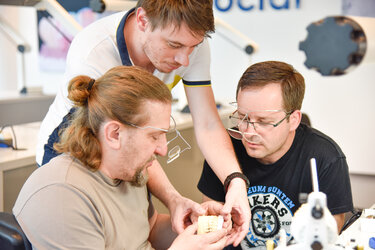
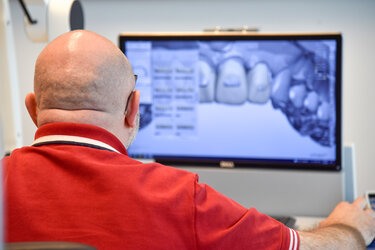
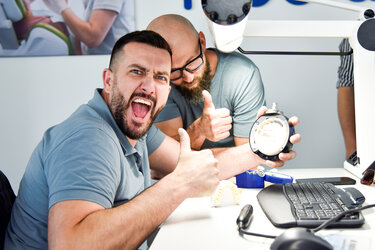

Different approaches
Monolithic restorations were fabricated from oxide ceramics and lithium disilicate. The lithium disilicate was milled using CAD/CAM technology and fabricated using the press technique.
The layered restorations were also designed very differently. They ranged from "minimal cut back layering" to incisal layering to full veneering and, as already described, were digital, analog or a combination of both worlds.
The preferences were also very different when it came to the materials used: lithium disilicate, milled or pressed in a wide variety of translucencies, combined with a wide variety of approaches when it came to the choice of layering materials.
From pure "staining/glazing" with IPS Ivocolor to highly complicated layering with IPS e.max Ceram and IPS e.max Selection materials and internal staining with IPS Ivocolor, everything was present.
3 restorations in the final selection
After completion of the dental technical work, all the restorations were tried in and Matija had the opportunity to choose his favorite from twelve different fronts.
Three restorations were shortlisted, and these were then tried in again under different lighting conditions at a different time of day in order to assess the esthetics and optical integration in the mouth even better.
In the end, the choice fell on crowns that were layered on an IPS e.max Press MO 0 coping with IPS e.max Ceram and IPS e.max Selection.
VivaStyle® Paint On Plus 10% / 16%
Virtual heavy/light Body
IPS e.max ZirCAD Prime
IPS e.max ZirCAD Prime Esthetic
IPS e.max CAD
IPS e.max Press
IPS e.max Ceram
IPS e.max Selection
IPS Ivocolor
VivaScan
Progra Scan 5
PrograPrint 5
PrograMill 7
Programat P710/510
Programat EP 5010r
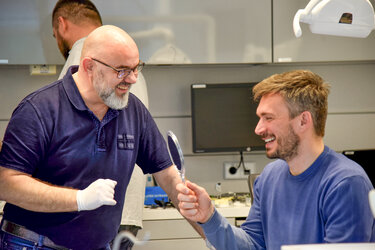
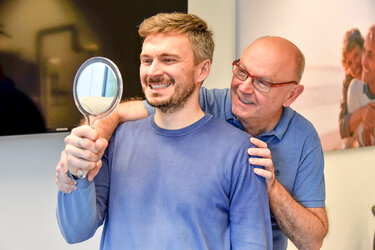
The one "right" way has not been around for a long time. It is the materials and workflows in the hands of skilled and capable dental technicians that create a work of art imitating nature and make a patient happy and give him/her back the smile.
Continuing education and "Life Long Learning" are fundamental pillars of Ivoclar. The idea of not only developing and marketing products, but also offering customers the opportunity to experience first-hand how to use them, has always been a top priority at Ivoclar.
